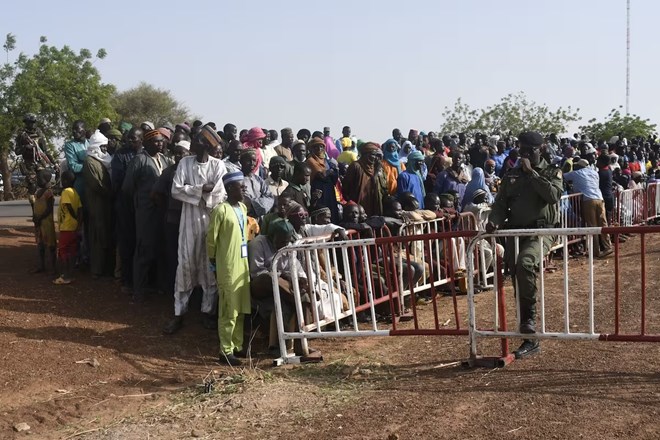
Tuesday December 5, 2023
By Rachel Chason

People displaced due to jihadist violence attend a meeting in Makalondi, southwestern Niger, in June 2022. (Boureima Hama/AFP/Getty Images)
DAKAR, Senegal — An African branch of the Islamic State that for years was an afterthought for the main organization is surging in strength, expanding the ranks of its fighters and controlling more territory than at any point since its founding in 2015, researchers say, part of a shift by the Islamic State from its traditional strongholds in Iraq and Syria to Africa.
Experts say the Islamic State-Sahel Province is ascendant in parts of Mali and Niger and, to a lesser extent, Burkina Faso, because of the security vacuum created by a drawdown of Western military assistance, most notably the departure of French soldiers — who were forced to end their missions by junta leaders — and the closing of the U.N. peacekeeping mission in Mali this year.
Another factor has been decisions made by the Islamic State’s rival group, the substantially larger al-Qaeda-affiliated Jamaat Nusrat al-Islam wal-Muslimin (JNIM), to focus its resources elsewhere after battlefield losses to the IS Sahel, essentially ceding vast tracts of land near the border between Mali and Niger.
After earning a reputation for brutality and indiscriminate violence, the Islamic State branch is now focusing more on governance in the towns and villages it controls, analysts said, and committing fewer atrocities against civilians.
“There is more organization in terms of indoctrination and recruitment,” said Guillaume Soto-Mayor, a nonresident scholar at the Middle East Institute. “And there are some types of violence that they now appear reluctant to use. They are showing off as a governing force.”
Soto-Mayor said that it is only recently that he has begun to hear of entire communities opting to join the Islamic State, some attracted by the imposition of strict sharia Islamic law in territories where governance is otherwise lacking and others because they lack the resources to move and rebuild their lives elsewhere. He said that as the group has grown, so too have its internal structures, including the number of schools where the next generation of soldiers are trained.
Since the death of Islamic State emir Abu Bakr al-Baghdadi in 2019, the organization has increasingly focused on its African provinces, including its branches in Somalia, the Democratic of Republic of Congo, around Lake Chad and elsewhere in the Sahel region, which cuts across the continent below the Sahara Desert.
Researchers say that the Islamic State Sahel Province — which counted just a few dozen combatants when the group’s founder Abu Walid al-Sahrawi pledged allegiance to Baghdadi in 2015 — has in the past few years begun to receive more attention from the Islamic State headquarters. Current estimates by researchers put the number of combatants at several thousand.
The Islamic State is “definitely more active in the Sahel and pulling off more attacks — both low and high-profile ones” than in Iraq and Syria, said Caleb Weiss, a senior analyst with the Bridgeway Foundation who is focused on Islamic State affiliates in Africa, although he cautioned that much of the Islamic State’s activity in the Middle East is underreported by the group or carried out in the shadows.
Weiss said that fighting between the Islamic State and JNIM, which is al-Qaeda affiliated, is the main factor constraining their growth. “It is a weird world — to counter the Islamic State, we rely on al-Qaeda,” said Weiss, adding that it is “JNIM who would provide the bulwark against any IS expansion, and vice versa.” And JNIM has other priorities, he noted, including in central Mali and pushing southward toward the coastal states of Ivory Coast, Benin, Togo and Ghana.
In the past year, the Islamic State has “expanded significantly” in areas around Gao and Ménaka in Mali, where JNIM and other armed groups had been dominant, said Héni Nsaibia, a senior researcher with the Armed Conflict Location and Event Data Project. Nsaibia said that battles between IS Sahel and JNIM have decreased since July, following successive conflicts in which IS Sahel came out victorious. “They realized that they faced common challenges and fighting was detrimental to each other,” he said, adding that the pause is probably temporary.
Nsaibia said the group’s use of violence remains common in towns and villages where it is still actively trying to expand although its strategies have evolved in the areas it already controls. While physical punishments are still enforced for lawbreakers, he said, there is more of a focus on rebuilding and managing infrastructure.